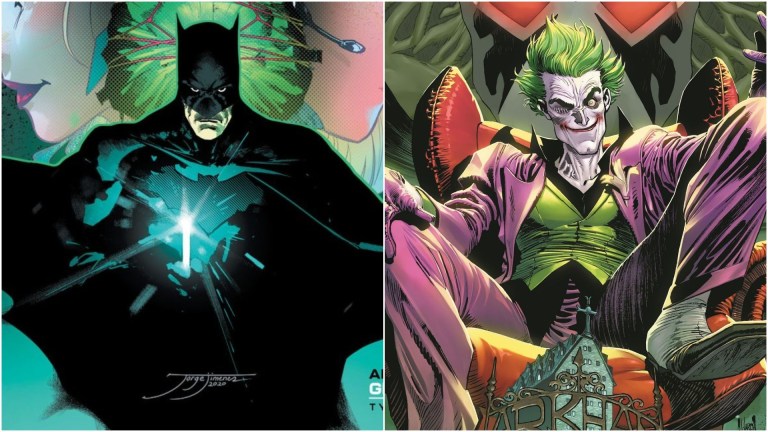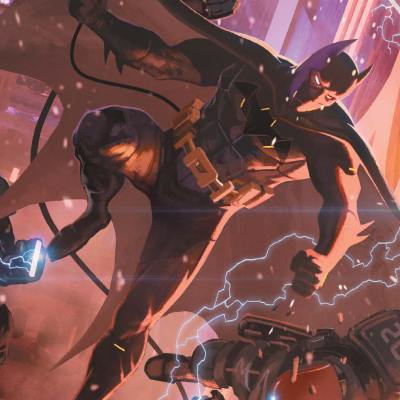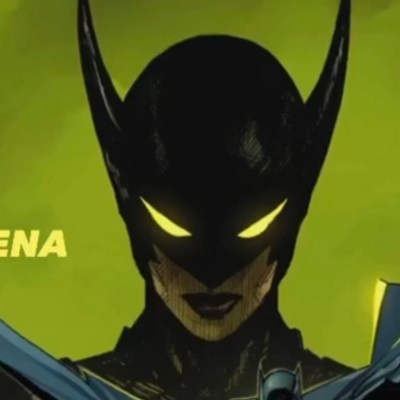What DC’s Infinite Frontier Means for Batman and Joker
DC's Infinite Frontier era will give us Batman and Joker like you've never seen them before. Writer James Tynion IV talks us through the next year of Bat stories, including what to expect from his big Scarecrow arc.

James Tynion IV has been writing Batman in some form or another for his entire career. He began his time at DC Comics by writing backup stories for Scott Snyder and Greg Capullo’s Batman during the New 52 era, fleshing out the history of the villainous Court of Owls before landing his first owl-centric series titled Talon. Tynion was one of the lead writers on Batman Eternal and Batman & Robin Eternal, two weekly series that mainlined years of Batman continuity back into the New 52. And following the Rebirth reset, he got a long run with the Bat family on Detective Comics.
With all that time on the Bat-books, it’s a little surprising to see the deluge of ideas still pouring out of the writer now that he’s got the flagship title all to himself. Tynion took over after Tom King’s 85-issue mega run, and proceeded to pit Batman against an entire city of clowns in “Joker War” after stripping the Dark Knight of his greatest superpower: his money. Tynion returns to the Dark Knight for the Infinite Frontier era, the post-Dark Nights: Death Metal status quo that has an energy to match Tynion’s voluminous idea output.
We had a chance to talk with him about a new year of Batman stories, his next big arc, and the surprising Joker solo book spinning out of “Joker War.”
This interview has been lightly edited for clarity.
Den of Geek: When we last talked to you, you were just getting Punchline into the wind and just getting cracking on Joker War. Now we’ve got Joker getting his own series, you’ve got Batman past the big 100th issue milestone. You’re the boss now, right?
James Tynion IV: :laughs: Right. And to be honest, when I came onto the title, the company had certain things that they were looking to accomplish with the Batman title. So I had a list of things that I needed to accomplish in the book, which is honestly part of why I leaned into creating so many new characters, especially once I got [artist] Jorge Jimenez as a creative partner. It was because those were the elements that I had the most control over. And in doing it because the company had where they wanted Batman to end at, where they wanted Joker then.
But then as things started to change and it started to look like I was going to be staying on the title for the long haul, they started asking me “totally blue sky, what would you do next year if you had total carte blanche to do whatever you want?” And I said “I want to do a Scarecrow story.”
There’s a Scarecrow story that has been in my head since I was working on the [Batman] Eternals, since I was working on Detective Comics. It’s changed a lot since then, but there there are some core pieces that I’ve wanted to explore in a big Batman story for years. And now taking everything I’ve learned from my first year on Batman, taking everything I’ve learned from working with Jorge Jimenez, and also just looking at the state of the industry and the state of DC Comics in particular, I wanted to try some new stuff. I wanted to see what was possible and sort of test the limits of how far we can push the Batman mythology and still have it feel like a Batman book. And that is what we’re up to next year, and I’m really really excited about it.
Scarecrow as a character has always been a great, classic Batman villain. But he’s also got some mission overlap. He’s creepy and scary like the Joker is. He’s a brilliant scientist like Hugo Strange. What makes Jonathan Crane stand out as different and important and worth examining to you?
Well, I think there’s a really interesting parallel between Dr. Crane and Batman, which is the fact that Batman, by putting on the costume, is trying to instill fear in people. That is part of the core mission of him trying to put on that costume. It’s the belief that criminals are a superstitious and cowardly lot and if he makes himself into something that seems inhuman and frightening, criminals are going to be scared out of their mind. In a weird way, it’s a psychological experiment on criminals that Batman is waging war with.
With Jonathan Crane, with Scarecrow, he is someone whose entire modus operandi is trying to unlock all of the secrets of fear and doing it with the amorality of a classic mad scientist. He doesn’t care how many people get hurt around him, but he’s genuinely fascinated in scientific terms. He thinks he is unlocking some of the truths of human nature and he’s willing to use the entire city as the testing grounds for that. But in a weird way, so is Batman. And that’s why the name of the big arc is “Cowardly Lot.”
Post-Joker War, you’re taking [the Joker] outside of Gotham, right? Where are you most excited to send him and why?
Honestly, there are a bunch of exciting places. I like showing him in places where it’s tonally incongruous for him to be. Like, I like Joker in the sun. It’s just the most bizarre thing possible with his pasty white skin, just him out on a beach laying with some sunglasses is really, really wild.
But tonally, what I was really excited to explore is the idea of what is the whole secret criminal underworld that spans across the globe? How do people like the Joker stay off of Batman’s radar for years at a time sometimes before they reemerge to cause their latest havoc? And what are the support systems that hide these people away and all of that.
One thing that I tapped into was a little bit of real life history, with the ratlines out of Europe at the end of the second World War, where a bunch of Nazis basically snuck into South America and changed their names and identities. And a lot of those similar systems are how organized crime evade the authorities and set down roots in places where you can’t be extradited.
Joker, in particular, he is someone who appears to be a part of that world, because he is part of organized crime. He is the Clown Prince of Crime. But at the same time, he is such a chaotic element that he cannot…he walks into those systems, and those systems think they can control and contain him, but they can’t. And so a lot of those players who have been burned by him before are just as eager to take the Joker down as the heroes of the world. So that’s some of the core pieces that we’re trying to unpack here.
The element of the Joker that I’m most excited about is the fact that Joker does not necessarily make a great protagonist, because he’s someone you can’t really get into the internal life of. So emotionally the real protagonist of the Joker series is going to be Jim Gordon, who is one of my all time favorite characters, and the character I’ve been missing writing the most while getting to make my mark on the Batman mythology. So getting to put him up front and center with all of his very personal enmity towards the Joker, that is really exciting. And it also gives the book its tone. I keep referring to Joker as a horror noir book. This is this is me trying to do something that feels a bit more like a work of crime fiction, with the horror knob dialed up to 11. I honestly think the first issue is one of the best things I’ve written for DC.
Joker is going to function more like a kind of Jason Voorhees, right? He’s a horror movie villain rather than the focus of the story?
He is. Everything in the book happens because of the Joker, and the Joker is in every single issue of the book. But it is about the people who are pursuing the Joker, and the Joker playing with the people who are pursuing. He is both the Hannibal Lecter and the Buffalo Bill of the book. There is still a Will Graham, Jim Gordon is the Will Graham/Clarice that he’s playing with along the way.
You are obviously a very well established horror guy, but the artists on your horror books generally have a certain art style to them. Something Is Killing The Children [Tynion and Werther Dell’Edera’s horror comic about exactly what it says on the label] and Department of Truth [Tynion’s book with Martin Simmonds about conspiracy theories that become real], they don’t look like your typical superhero books. Guillem March has a vastly different art style to what Martin Simmonds and Werther Dell’Edera are doing on the other books. Has Guillem’s art style changed your approach to the horror in Joker at all? Or has your horror brought something different out of Guillem’s art?
One of my first books for DC comic was a title called Talon back in 2014, and Guillem March was the artist. I had been a fan of Guillem’s work, but I started realizing how good he was at the horror moments. Because he has this style that, I think you can see a lot of Joe Kubert. In his line work, it has a kind of Gothic edge to it. I’ve always loved writing some really scary moments for him. And I tried to tap into that, again with Batman…I think that his work on [Joker] so far is my favorite stuff he’s done in all the time that we’ve worked together, which has been pretty much my entire career.
Who’s your definitive Joker? When you’re dragging in a script, what Joker stories do you go back to to try and catch his voice again?
Oh, boy, that’s a really good question. One of the north stars just because of how closely I’ve worked with him, and for how long, is the Scott Snyder Joker. I think Scott got into the Joker’s head more than almost any other writer in the modern era. There’s a certain element of the Joker as the devil who just knows how to hit every single emotional pressure point on your body to make you afraid and to pick you apart. And the idea of him being almost ever present and in this solitary, terrifying way. So there’s an element of that, that I always bring in.
But I’m never going to be able to shake the Mark Hamill voice from my head. There is an element of Joker when he’s at his most performative and he’s always performing to an audience, [but] it depends who the audience is. Sometimes the audience is Batman, but his voice changes a little when he’s talking to other villains and those are the stories that I’ve always loved. When I was doing my Legion of Doom one shots during Scott Snyder’s Justice League run, writing him as a foil for Lex Luthor was incredibly fun. Even going all the way back when I was doing the backup stories in the New 52, writing a Joker up against Two Face or up against Penguin or up against Riddler. He has a very different dynamic with all of them that is a little more playful because he’s not trying to kill them. He’s just trying to mess with them. So that Joker gets a little more Mark Hamill where he is a bit more of the clown.
But honestly, my favorite Joker story ever is Batman Beyond: Return of the Joker. I think it captures all of the sides of him. It’s him at his most performative, but you also see the deep hatred and also the incredible intelligence of the character, which is the thing that makes him so dangerous. The Joker would not be effective if he wasn’t as smart as Batman. The scary thing is he’s always playing a larger game. And it’s a larger game that does not necessarily follow a logic, but he can follow every step of it.
So we’ve got Jim [Gordon] in the Joker book. I’ve also read Barbara [Gordon], Bluebird, Punchline, [canonical best Batgirl] Cass [Cain], and Stephanie Brown are all showing up there.
Yeah, in the Joker book, there are also going to be backup stories continuing from the Punchline one-shot that I co-wrote back in November of last year, and continuing the story of Leslie Tompkins and Bluebird investigating Punchline’s past while she’s on trial for her crimes committed during the Joker War event. That story is going to continue there.
Barbara Gordon is going to play a key role in that book, especially her relationship with Jim Gordon. Joker looms large in both of their pasts but also in both of their recent pasts. In the Joker War tie-in issues, we saw the death of James Gordon Jr. and that’s going to be one of the key things that sets the story in motion here. So, there is both a loss in their family instigated by the Joker that sets the Gordon family on this journey.
The Gordon family is a very central force in the book, and tied very closely into that is the new arrangement in which we have Barbara Gordon working a bit more [behind the scenes, but] has not fully given up the Batgirl costume. But she is working more and more as Oracle again. And because she’s behind the computer, she is using Cassandra Cain and Stephanie Brown as her agents in the field, as her Batgirls. And so we are playing and building out that whole dynamic.
A lot of people are very happy with that.
I’m very happy about it. :laughs: And we have big plans for all of the Batgirl characters in the line that will become more and more clear as the year goes on.
Is everything pointing back towards each other? You’ve got the big Scarecrow story in Batman, you’ve got all of the toys that you’ve brought into the Bat-family hanging around with Clownhunter and with Ghostmaker. But it sounds like they’re kind of eventually going to converge again.
Oh, absolutely. You can’t have two parallel threads going if you don’t plan to have them intersect. And honestly, one of the big things that I am most excited about this next era is how closely together all of the writers are working. There are certain things you can only pull off in a connected superhero universe. And especially like in the era right now, there is an incredible opportunity at DC which is, we have Black Label and books in the YA space and all of that. There are more straight up the middle, back to basics Batman stories being told that are more in the classic mold. And then there is stuff written for all ages audiences with the Bat family characters. So it frees the main line books to go a little further, where we don’t need to reset everything to the status quo, we can kind of push the status quo a little bit and change it
The guiding idea that I’ve been going back to over and over is we’re further down the timeline than we’ve ever been before. If you look at Batman The Animated Series as a kind of core archetypal peak Batman moment where you have Batman, you have Bat Signal in the sky, you have Jim Gordon on the roof of the GCPD, you have a Tobin at his side, he’s in Wayne Manor, and Alfred’s in the Batcave. That is the era of peak Batman. And then you see at the end of the spectrum, you have stories like The Dark Knight Returns and Batman Beyond. We’re now at the midpoint of those two points. And that’s really exciting to me. Because you get to play with a Batman who’s a little worried that he used to be more effective than he is. Because when he first came on the scene, he cleaned up crime, he was all that, he made it for a better city, but then everything started pushing back even harder. And the city started becoming a more dangerous thing.
And now Bruce Wayne is no longer a billionaire. He’s still wealthy, still a millionaire, but now he can’t just buy up all of Gotham City and try to fix it. He’s having to re-approach what he’s doing, build his methods back from the ground up. He’s doing it with the Bat family. But this is not an all powerful Bat God who can solve any problem that’s put in front of him in 30 seconds. This is someone who has to do the grunt work, the detective work, and touch up on his training and push himself to new limits, despite the fact that he’s not as young as he used to be. And I think that that makes for exciting storytelling.
I’m really excited. And seeing how the other writers in the line are tapping into the new elements of the status quo. The hope is creating an era of Batman comics that people come back to long into the future. I want people to look at this era and be like, “that’s my favorite era of Batman.”


